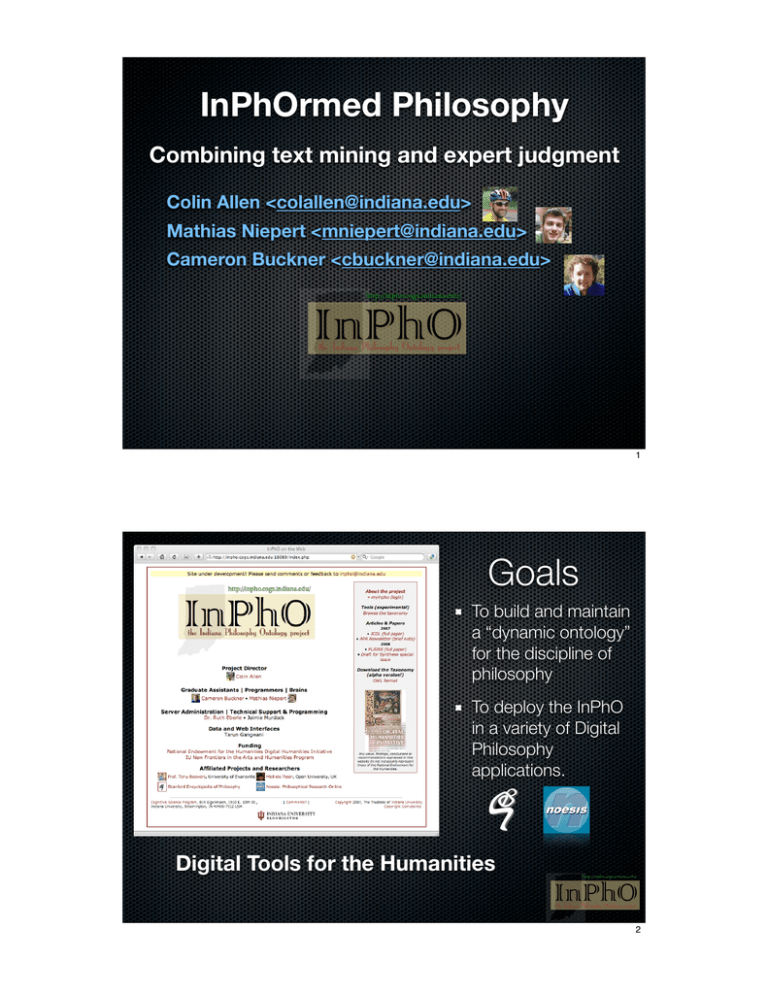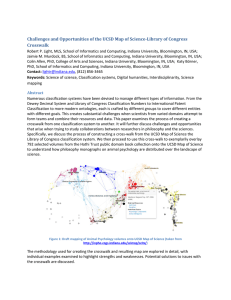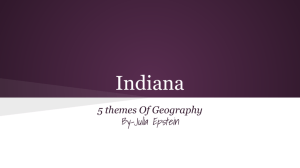InPhOrmed Philosophy
advertisement

InPhOrmed Philosophy Combining text mining and expert judgment Colin Allen <colallen@indiana.edu> Mathias Niepert <mniepert@indiana.edu> Cameron Buckner <cbuckner@indiana.edu> http://inpho.cogs.indiana.edu/ InPhO the Indiana Philosophy Ontology project 1 Goals To build and maintain a “dynamic ontology” for the discipline of philosophy To deploy the InPhO in a variety of Digital Philosophy applications. Digital Tools for the Humanities http://inpho.cogs.indiana.edu/ InPhO the Indiana Philosophy Ontology project 2 http://inpho.cogs.indiana.edu/ InPhO the Indiana Philosophy Ontology project 3 InPhO Architecture Overview http://inpho.cogs.indiana.edu/ InPhO the Indiana Philosophy Ontology project 4 SEP Data 1289 authors (+12) 114 subject editors (+1) 1037 published entries (+20) 12.05 million words (+250,000) 600-850K articles accessed/week http://inpho.cogs.indiana.edu/ InPhO the Indiana Philosophy Ontology project 5 Other data sources http://inpho.cogs.indiana.edu/ InPhO the Indiana Philosophy Ontology project 6 Wanted: Structured Data Out Ontology: formal, machine-readable specification of the types of entities in a domain and relationships between them http://inpho.cogs.indiana.edu/ InPhO the Indiana Philosophy Ontology project 7 http://inpho.cogs.indiana.edu/ InPhO the Indiana Philosophy Ontology project 8 Bridging the Data-Metadata Gap Two “extremes”: Hire experts to design & maintain an ontology Problems: labor-intensive, expensive, depends on “double” experts Tagging approaches, folksonomies Problems: may not meet academic standards; noisy http://inpho.cogs.indiana.edu/ InPhO the Indiana Philosophy Ontology project 9 Building ontologies: A third way Stratified collaboration Authors & Editors (Experts) Expert feedback software Ontology Model Induction (Answer Sets) General feedback software Expert-written content semi expert input and usage Software Semantic/Statistical Analysis The InPhO “layer cake” http://inpho.cogs.indiana.edu/ InPhO the Indiana Philosophy Ontology project 10 • Experts are busy people. Experts don’t Authors & Editors (Experts) Ontology Model Induction (Answer Sets) want to be bothered with garbage. Experts don’t like their hard work messed up by amateurs. • Knowledgeable amateurs often have more semi expert input and usage Software Semantic/Statistical Analysis time and motivation to fix things, but they are rare. They don’t like having their hard work messed up by the clueless either. • Well-intentioned amateurs are plentiful and motivated to donate their time, But they make mistakes. • Software has lots of time, has no motivation problems but is clueless. http://inpho.cogs.indiana.edu/ InPhO the Indiana Philosophy Ontology project 11 Two networks authors, editors, readers, etc. 12 Software Layer 1 Is it possible to detect hyper/hyponymy statistically? If t1 is a hypernym of t2 then t1 is semantically similar to t2 t1 is more general than t2 with respect to a taxonomy Probabilistic J-measure widely used to estimate the semantic similarity between two terms: http://inpho.cogs.indiana.edu/ InPhO the Indiana Philosophy Ontology project 13 Semantic similarity We build a directed and weighted co-occurrence graph G = (V , E) in which each node represents a term in our set of keywords. An edge between two terms t1 and t2 indicates that the terms co-occur in the encyclopedia at least once and the weight of the edge is a measure of their semantic similarity By iterating over all documents in the encyclopedia and counting their term (co-)occurrences we can estimate the probabilities p(ti ), p(tj ), p(ti,tj ), and thus p(ti|tj ) for all terms ti, tj, with respect to a unit of text. Currently we consider a document and a one sentence sliding window as units of text; i.e. two co-occurrence records are created, one for the sentence level and one for the document level. The latter is projected into the former by treating an entire document as one large sentence, giving us more co-occurrences at the cost of possibly including some connected but unrelated terms in our graph. http://inpho.cogs.indiana.edu/ InPhO the Indiana Philosophy Ontology project 14 Hyper/hyponymy We hypothesize encyclopedias are “balanced” – terms representing more general categories tend to co-occur with more terms in the encyclopedia’s text. Normalized node in degree will usually be a good measure for the generality of category, but we anticipate that entropy is an even better approximation of generality because it not only takes into account the in-degree of the node but also how evenly its adjacent nodes are conditionally distributed. Node entropy provides a measure for generality that can be used to rank hypernym/hyponym candidates via the “R-measure” (Niepert et al. 2007): http://inpho.cogs.indiana.edu/ InPhO the Indiana Philosophy Ontology project 15 http://inpho.cogs.indiana.edu/ InPhO the Indiana Philosophy Ontology project 16 Leveraging Expertise Authors & Editors (Experts) Simple question interface to gather feedback on statistically generated “hypotheses” Automated (nonmonotonic) reasoning to put the pieces together (Answer Set Programming) Ontology Model Induction (Answer Sets) semi expert input and usage Software Semantic/Statistical Analysis http://inpho.cogs.indiana.edu/ InPhO the Indiana Philosophy Ontology project 17 http://inpho.cogs.indiana.edu/ InPhO the Indiana Philosophy Ontology project 18 http://inpho.cogs.indiana.edu/ InPhO the Indiana Philosophy Ontology project 19 Software 2 Is it possible to use possibly conflicting evalautions? Yes: Non monotonic reasoning. We use answer-set programming. http://inpho.cogs.indiana.edu/ InPhO the Indiana Philosophy Ontology project 20 Answer Set Programming Three parts: Signature: predicate symbols (e.g., desc) and set of terms (here: terms referring to ideas in Philosophy) Declaration: Set of feedback facts, (e.g., morespecific(Neural Network, Connectionism)) and the facts given by the existing ontological structure (e.g., is-a(Thinking Machines, Artificial Intelligence)) Regular Part (set of rules) http://inpho.cogs.indiana.edu/ InPhO the Indiana Philosophy Ontology project 21 Answer Set Programming Conflicting Feedback Conflicting feedback is possible! Modeled using predicate ic (inconsistent): ic(X, Y) :- ms(X, Y), mg(X, Y). Can be used to model “semantic links” between incomparable ideas: plink(X, Y) :- s4(X, Y), ic(X, Y), not desc(X, Y), class(X). http://inpho.cogs.indiana.edu/ InPhO the Indiana Philosophy Ontology project 22 Quality of response Is it possible to use feedback according to quality? If X is an author or editor at the SEP, then X is an expert in subject areas a, b, ... If Y provides feedback in area a that is well correlated with experts in a, then Y’s feedback about edge E in a may be trusted in the absence of contrary expert feedack. http://inpho.cogs.indiana.edu/ InPhO the Indiana Philosophy Ontology project 23 Untitled 2 Managing Expertise Is it possible to use feedback according to quality? If X is an author or editor at the SEP, then X is an expert in subject areas a, b, ... If Y provides feedback in area a that is well correlated with experts in a, then Y’s feedback about edge E in a may be trusted in the absence of contrary expert feedack. 10/20/08 5:53 PM %stratified input predicates are named same as unstratified counterparts but with "i" su!x rating(0). rating(1). rating(2). rating(3). rating(4). %process expert-level-stratified input versions of predicates into those used by program %inverse msi(X, Y, A) " mgi(Y, X, A), rating(A). mgi(X, Y, A) " msi(Y, X, A), rating(A). %similarity symmetry p4i(X, Y, A) " p4i(Y, X, A), rating(A). p3i(X, Y, A) " p3i(Y, X, A), rating(A). %incomparable symmetry ici(X, Y, A) " ici(Y, X, A), rating(A). %evidence against similarity ratings if contradicted by those at a higher level np4(X, Y, A) " p4i(X, Y, A), p0i(X, Y, B), B>A, rating(A), rating(B). np4(X, Y, A) " p4i(X, Y, A), p1i(X, Y, B), B>A, rating(A), rating(B). np3(X, Y, A) " p3i(X, Y, A), p0i(X, Y, B), B>A, rating(A), rating(B). np3(X, Y, A) " p3i(X, Y, A), p1i(X, Y, B), B>A, rating(A), rating(B). %if no evidence against the similarity at that level, allow to pass through the "filter" p4(X, Y) " p4i(X, Y, A), not np4(X, Y, A), rating(A). p3(X, Y) " p3i(X, Y, A), not np3(X, Y, A), rating(A). %allow lower-level generality evaluations to pass through if not contradicted by a higher level %mg(X, Y) " mgi(X, Y, A), rating(A), rating(B), not msi(X, Y, B), B>A. %ms(X, Y) " msi(X, Y, A), rating(A), rating(B), not msi(X, Y, B), B>A. %evidence against the generality ratings at one level if contradicted by those at a higher level nmg(X, Y, A) " mgi(X, Y, A), msi(X, Y, B), B>A, rating(A), rating(B). http://inpho.cogs.indiana.edu/ nms(X, Y, A) " msi (X, Y, A), mgi(X, Y, B), B>A, rating(A), rating(B). InPhO %if no evidence against the generality at that level, allow to pass through the the Indiana Philosophy Ontology project 24 Page 1 of 4 Representing Philosophy Three Models Wiki — Power to the people! The world is flat! Peer reviewed — Experts know best! Mountaintop sanctuaries (SEP, “Formal” Ontology ) Stratified — From each according to ability! A complex landscape (InPhO) http://inpho.cogs.indiana.edu/ InPhO the Indiana Philosophy Ontology project 25 26





